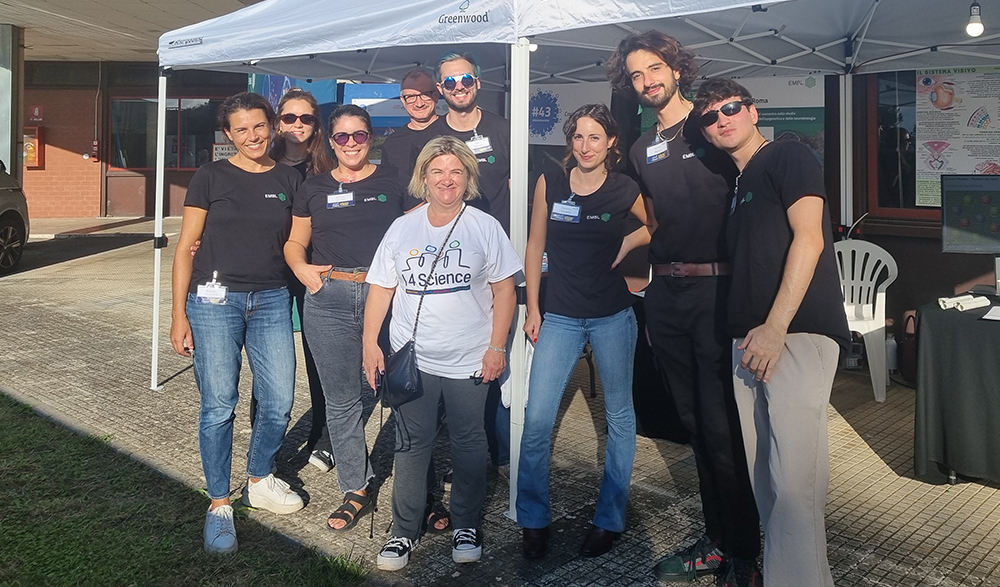
Read the latest Issue
EMBL Rome volunteers participated in the European Researchers’ Night with activities and games reflecting the variety of research projects conducted at the site and across EMBL

The European Researchers’ Night (ERN) is an event promoted by the European Commission since 2005 that involves thousands of institutions across Europe and takes place every year on the last Friday of September. It targets the general public, addressing and attracting people, especially non scientists, with a special focus on young people and families.
Like last year, EMBL Rome contributed to the ERN through an event organised by the Research Area ‘Roma 1’ of the National Research Council (CNR) in Montelibretti, (near the EMBL Rome campus) which includes eleven CNR Institutes. Besides EMBL, about 25 external partners participated in the event, including EMBL Rome campus partners CNR-IBBC and the Association Adamas Scienza.
Over 300 volunteers from the participating institutes (scientific, administrative, and technical staff) were involved in preparing and conducting more than 70 activities offered to the general public, ranging from workshops, talks, exhibitions, and lectures to games and interactive experiments. In particular, this year’s event was organised in the framework of the I4SCIENCE project, submitted by the organisers as part of the Horizon Europe Call. The proposed activities were therefore organised around four keywords that reflect the values and objectives of this initiative: Innovation, Imagination, Integration, and Impact of Science.

EMBL Rome volunteers organised various activities to raise awareness about the wide variety of projects and research activities conducted at EMBL. In one stand, young visitors could engage in ‘Run, Scientist, Run!’, a game conceived by EMBL’s Science Education and Public Engagement (SEPE) department. The game, which provides an inside view of the world of coastal ecology research, was inspired by the Traversing European Coastlines (TREC) expedition.
Another activity (designed by Gemma Noviello and Sofia Rucli, postdocs in the Hackett and Boulard groups respectively) aimed to explain how epigenetic factors can influence cell fate. By adapting a commercially available coding game, they showed how stem cells differentiate into specialised cell types based on the input from their environment. Participants could then test the game and ‘program’ the specific signals that would guide the cell towards a particular differentiation pathway.

A second stand focused on neuroscience, in particular, the visual system and optical illusions.
People of all ages were entertained by 3D images, tricks, and illusions used to explain how our binocular visual system works and how the brain perceives the world around us.
Finally, the DNA bracelet and origami-making station attracted many children, who had the opportunity to learn about the structure and function of DNA – the ‘molecule of life’.
Overall the event was a great success, with over 1,500 visitors in one evening.

“My experience at the European Researchers’ Night was truly exciting!” said Simone Papa, master’s student in the Asari group. “From the afternoon until late in the evening, I had the chance to interact with a large and heterogeneous audience, including work colleagues, researchers, or simply children and parents interested in our work. The opportunity to show the complexity of our visual system, and how our brain can be tricked through optical illusions, attracted several spectators. Sharing one’s passion and perceiving surprise and curiosity in people’s eyes was very inspiring for me, because this is what science is all about: finding out more about how things work, going home with new answers, but many questions too!”
“We scientists spend most of our time in the laboratory, and the chances to discuss science outside the academic context are very rare,” said Sofia Rucli. “Learning to convey scientific concepts concisely and clearly is one of the most difficult challenges we can face. Translating a complicated question into a simple concept and improving basic scientific knowledge to help society should be the core of our daily motivation. This experience reminded me how important scientific outreach is to strengthen the connection between science and society, to support and be supported by society.”
Looking for past print editions of EMBLetc.? Browse our archive, going back 20 years.
EMBLetc. archive